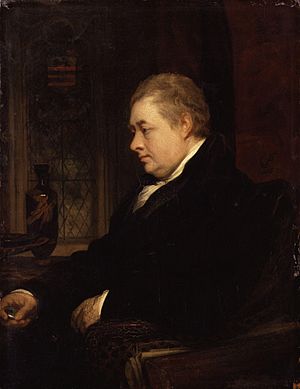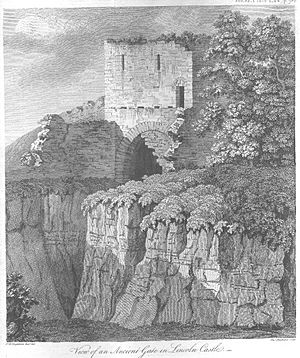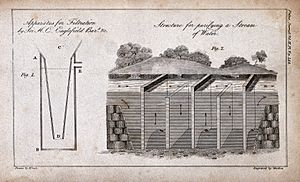Henry Englefield facts for kids

Sir Henry Charles Englefield, 7th Baronet (1752 – 21 March 1822) was an English antiquary and astronomer. An antiquary is someone who studies old things and history. Sir Henry was also a member of several important learned societies. He was known for his research in many different fields of science and history.
Life of Sir Henry Englefield
Sir Henry was born in 1752 at Englefield House, which was his family's home near Reading, Berkshire. He was the oldest son of Sir Henry Englefield, 6th Baronet. His mother was Catherine Buck. When his father passed away in 1780, Henry inherited the family title and estates. These estates included Whiteknights and Wootton Bassett.
In 1778, when he was 26 years old, Sir Henry was chosen to be a Fellow of the Royal Society. This is a group for important scientists. The next year, he became a Fellow of the Society of Antiquaries. This society studies old things and history. For many years, he was the vice-president of the Society of Antiquaries. He even became its president for a short time.
However, some people did not want him to be re-elected as president. This was partly because he was a Catholic. Also, he disagreed with the election of an architect named James Wyatt to the society. Because of these reasons, he was replaced by the Earl of Aberdeen. Even so, under his guidance, the society created many detailed drawings of English cathedrals. Sir Henry wrote about the cathedrals of Durham, Gloucester, and Exeter.

In 1781, Sir Henry joined the Dilettanti Society. This group was interested in art and ancient Greek and Roman culture. He worked as its secretary for fourteen years. Besides studying old things, he also did research in chemistry, mathematics, astronomy, and geology. He even won a gold medal from the Society of Arts. This was for his discovery of a special lake made from madder, a plant used to make red dye.
Sir Henry did not take part in politics much. This was because Catholics faced some restrictions at the time. However, he was friends with a famous politician named Charles James Fox. His portrait was painted by a well-known artist, Sir Thomas Lawrence. Two bronze medals were also made with his image on them.
In 1782, Sir Henry was elected to the Catholic Committee. This group worked to improve the rights of Catholics in England. He wrote a pamphlet supporting Catholic rights. He also took an independent stand during discussions about the Catholic Relief Bill of 1791. This bill aimed to give more rights to Catholics.
Towards the end of his life, Sir Henry's eyesight started to fail. He never got married. He passed away in London in 1822. The baronetcy, which is a special title, ended with him. He is buried in Englefield Churchyard.
Works of Sir Henry Englefield
Sir Henry Englefield wrote many books and papers during his life. Here are some of his important works:
- Tables of the Apparent Places of the Comet of 1661 (published in 1788)
- On the Determination of the Orbits of Comets (published in 1793)
- A Walk Through Southampton (published in 1801)
- Description of a New Transit Instrument, Improved by Sir H. Englefield (published in 1814)
- The Andrian, a Verse Translation from Terrence (published in 1814)
- Description of the Principal Beauties, Antiquities and Geological Phenomena of the Isle of Wight (published in 1816). This book included his own drawings.
- Observations on the Probable Consequences of the Demolition of London Bridge (published in 1821)
He also wrote many papers for different societies. These included the Society of Antiquaries, the Royal Society, and the Linnaean Society. His articles also appeared in scientific journals like Nicholson's Journal and Tilloch's Philosophical Magazine.


